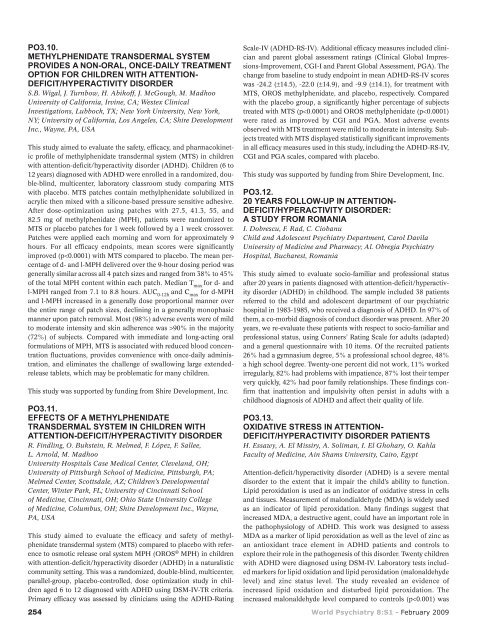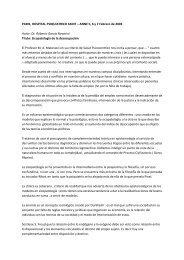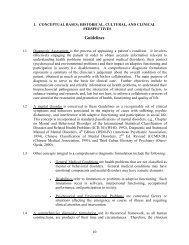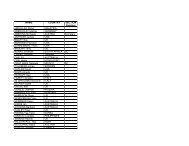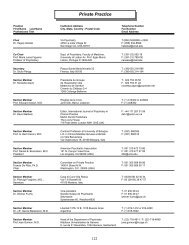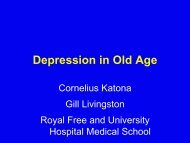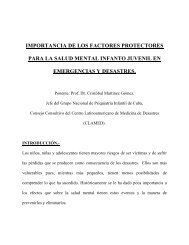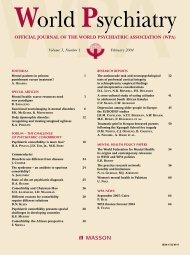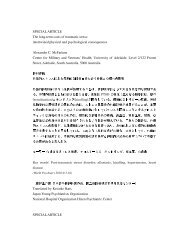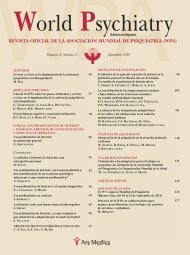ABSTRACTS - World Psychiatric Association
ABSTRACTS - World Psychiatric Association
ABSTRACTS - World Psychiatric Association
You also want an ePaper? Increase the reach of your titles
YUMPU automatically turns print PDFs into web optimized ePapers that Google loves.
PO3.10.<br />
METHYLPHENIDATE TRANSDERMAL SYSTEM<br />
PROVIDES A NON-ORAL, ONCE-DAILY TREATMENT<br />
OPTION FOR CHILDREN WITH ATTENTION-<br />
DEFICIT/HYPERACTIVITY DISORDER<br />
S.B. Wigal, J. Turnbow, H. Abikoff, J. McGough, M. Madhoo<br />
University of California, Irvine, CA; Westex Clinical<br />
Investigations, Lubbock, TX; New York University, New York,<br />
NY; University of California, Los Angeles, CA; Shire Development<br />
Inc., Wayne, PA, USA<br />
This study aimed to evaluate the safety, efficacy, and pharmacokinetic<br />
profile of methylphenidate transdermal system (MTS) in children<br />
with attention-deficit/hyperactivity disorder (ADHD). Children (6 to<br />
12 years) diagnosed with ADHD were enrolled in a randomized, double-blind,<br />
multicenter, laboratory classroom study comparing MTS<br />
with placebo. MTS patches contain methylphenidate solubilized in<br />
acrylic then mixed with a silicone-based pressure sensitive adhesive.<br />
After dose-optimization using patches with 27.5, 41.3, 55, and<br />
82.5 mg of methylphenidate (MPH), patients were randomized to<br />
MTS or placebo patches for 1 week followed by a 1 week crossover.<br />
Patches were applied each morning and worn for approximately 9<br />
hours. For all efficacy endpoints, mean scores were significantly<br />
improved (p90% in the majority<br />
(72%) of subjects. Compared with immediate and long-acting oral<br />
formulations of MPH, MTS is associated with reduced blood concentration<br />
fluctuations, provides convenience with once-daily administration,<br />
and eliminates the challenge of swallowing large extendedrelease<br />
tablets, which may be problematic for many children.<br />
This study was supported by funding from Shire Development, Inc.<br />
PO3.11.<br />
EFFECTS OF A METHYLPHENIDATE<br />
TRANSDERMAL SYSTEM IN CHILDREN WITH<br />
ATTENTION-DEFICIT/HYPERACTIVITY DISORDER<br />
R. Findling, O. Bukstein, R. Melmed, F. López, F. Sallee,<br />
L. Arnold, M. Madhoo<br />
University Hospitals Case Medical Center, Cleveland, OH;<br />
University of Pittsburgh School of Medicine, Pittsburgh, PA;<br />
Melmed Center, Scottsdale, AZ; Children’s Developmental<br />
Center, Winter Park, FL; University of Cincinnati School<br />
of Medicine, Cincinnati, OH; Ohio State University College<br />
of Medicine, Columbus, OH; Shire Development Inc., Wayne,<br />
PA, USA<br />
This study aimed to evaluate the efficacy and safety of methylphenidate<br />
transdermal system (MTS) compared to placebo with reference<br />
to osmotic release oral system MPH (OROS ® MPH) in children<br />
with attention-deficit/hyperactivity disorder (ADHD) in a naturalistic<br />
community setting. This was a randomized, double-blind, multicenter,<br />
parallel-group, placebo-controlled, dose optimization study in children<br />
aged 6 to 12 diagnosed with ADHD using DSM-IV-TR criteria.<br />
Primary efficacy was assessed by clinicians using the ADHD-Rating<br />
Scale-IV (ADHD-RS-IV). Additional efficacy measures included clinician<br />
and parent global assessment ratings (Clinical Global Impressions-Improvement,<br />
CGI-I and Parent Global Assessment, PGA). The<br />
change from baseline to study endpoint in mean ADHD-RS-IV scores<br />
was -24.2 (±14.5), -22.0 (±14.9), and -9.9 (±14.1), for treatment with<br />
MTS, OROS methylphenidate, and placebo, respectively. Compared<br />
with the placebo group, a significantly higher percentage of subjects<br />
treated with MTS (p


